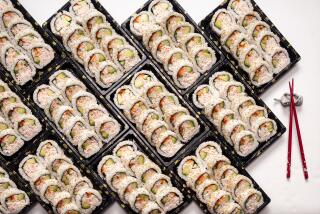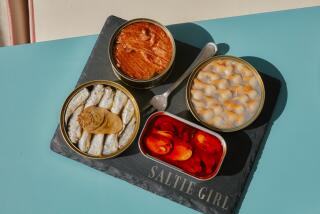FROM THE SEA ABALONE : Prized Harvest : As abalone grows scarce in its natural habitat, a marine biologist farms the delicacy in tanks.
- Share via
Of all the ocean’s delicacies--lobster, salmon, caviar and the like--abalone, is the favorite of many gourmet seafood enthusiasts.
And it isn’t just the meat of this shelled mollusk that makes it so prized. The ear-shaped armor is the basis for mother-of-pearl jewelry and gift items that can be found in seaside communities the world over.
The abalone’s popularity has just about done it in. Over-harvesting, coupled with pollution, has vastly decreased abalone numbers in our waters over the years.
A Port Hueneme marine biologist took notice of the decline.
With the hope of bolstering populations, Jim McMullen created a laboratory that would farm abalone for the purpose of transplanting them to the deep blue.
“That’s how Ab Lab originally started,” manager Michael Machuzak said. “Sixteen years ago it was a small project to provide for reseeding.”
Today, Ab Lab, located on the Naval Civil Engineering Base in Port Hueneme, has branched out. Though they continue to supply the Department of Fish and Game with occasional seed abalone, Ab Lab’s customers now include restaurateurs and anyone else wanting to purchase the seafood treat.
“We produce the red abalone,” Machuzak said, “which is the fastest growing and easiest to farm.” There are about eight varieties of abalone that can be found along the California coast, he said.
Ab Lab’s culture methods allow it to produce annually upwards of 3 million seed abalone.
The propagation starts with spawning.
Immersed in seawater-filled tanks, each female blows millions of pinhead-sized eggs through a small respiratory pore in its shell. “The eggs shoot right through,” Machuzak said.
Eggs gathered, Ab Lab then bathes them in a wash of male sperm, collected through a procedure that induces release.
“In the wild, the male simply broadcasts his sperm over the eggs,” he said, “whereas our method eliminates the by-chance fertilization.”
Machuzak said wild abalone “are lucky to fertilize even 1% of the eggs.” Ab Lab’s technique, he said, ensures about a 30% survival rate.
A remarkably short 24 hours later, eggs that were fertilized begin to hatch. “The larvae look like little round, light or dark green circular things with cilia,” he said. The cilia--rhythmically beating, hairlike growths--provide the larvae locomotion.
“They have the ability to swim for seven days,” he said. And after just two days, the larvae “have a shell that looks like that of a garden snail.”
After the larvae’s seven-day frolic, they are moved to one of Ab Lab’s 700 60-gallon tanks, each holding 30,000 to 50,000 larvae.
“When they reach 10 millimeters, they’re either sold to other growers or allowed to grow another 28 months in our tanks,” Machuzak said. Ab Lab sells to other wholesalers and restaurants across the nation.
It will take the red abalone about 3 years to grow 3 inches, or “roughly an inch a year,” he said.
Abalone, “sea snails,” have basic eyes that sense light and a snout, Machuzak said, and feed on kelp and brown algae. “Their mouth is like a raspy tongue, sort of like a cat’s, and they just munch away on the kelp.”
Ab Lab sells its red abalone to the wholesale and retail seafood markets upon reaching two sizes; 2 1/4- and 2 3/4-inches.
The legal size to take red abalone in the ocean is 7 3/4-inches, Machuzak said, “but it just takes too long to culture that large.”
Bad luck for the poor little devil who ends up covered in lemon butter sauce when still so young, but Machuzak reminded us, “The sale of cultured abalone doesn’t endanger the depleted wild stock.”
Most chefs, as well as retail customers, prefer the smaller sizes anyway, he said, because they are more tender and easier to handle during preparation.
“Restaurateurs also like to have farmed product,” Machuzak said, “because it’s a more reliable source, whereas fishermen are dependent upon such things as weather conditions that can hamper their daily take.”
Ab Lab, the only one of its kind in Southern California, takes requests for its cultured abalone via telephone and offers only live-in-shell product. “There’s no processing,” Machuzak said, “it’s never frozen.”
The abalone can be specially packaged and shipped to the customer. “Red abalone is about $2.25 per piece,” he said. Tours of the facility are conducted occasionally. For more information, call 488-6137.
More to Read
Eat your way across L.A.
Get our weekly Tasting Notes newsletter for reviews, news and more.
You may occasionally receive promotional content from the Los Angeles Times.








